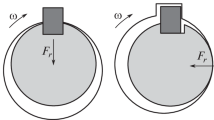Abstract
The paper is about a new coupling design that can be used to connect two shafts in the same line without any axial or angular misalignment. The goals of the new design are to reduce the amount of material required to produce other couplings and reduce the chances of failure due to different stress distribution patterns. Rigid flanged coupling is used as a reference for comparison. The design consists of mainly three parts body, pins and logs (strips of metal used to connect the body). The holes are done on outer surfaces of the hexagonal or a square prism of each body while one surface of each body faces each other. The logs are used to join the two bodies with the help of pins in the holes. The coupling is designed using Autodesk Fusion 360. Proper mathematical analysis of the couplings is done to get the difference in the material used. This design can be used to connect both, shafts with the same diameter or shafts with different diameters. The design has less stress concentration around holes and in whole design in general and is similar in the manufacturing process as the presently available couplings. For the safety of the operator or user, the coupling is covered with a protective case to avoid the failed parts (if any) to hit the operator or the user. The dimensions are found using stress analysis and considering the modes of failure for each section of the part. Shear and tensile failure have been considered at the parts of the assembly. The bending effect has also been considered for parts wherever adequate. The stress analysis results have also been found out using Autodesk Fusion 360. To observe the effects and results of stress analysis, similar working conditions have been simulated with the coupling designed in Autodesk Fusion 360.
Access provided by Autonomous University of Puebla. Download conference paper PDF
Similar content being viewed by others
Keywords
1 Introduction
Most of the rigid couplings popularly in use today comprise two flanges attached to each other and transmitting motion, power and torque. This particular method of coupling is required to join two shafts that are one from the power receiving end and the other power generation end. The flanges, for manufacturing, require a lot of metal and due to the various methods by which they are joined, stress is also concentrated to certain parts which lead to failure of the flanges or a high factor of safety needs to be considered.
The use of the designed coupling is to use less material considering the same factor of safety and even more reduction of material when less factor of safety is considered due to the reduction in stress concentration in power transmission areas.
2 Design Process
2.1 Logged Coupling
2.2 Empirical Relations [1]
Empirical relations are mostly the pre derived, assumed and universally accepted relations. In this derivation, the empirical relations are kept the same as rigid flanged coupling.
In the above relations, the terms used have the following meanings (Table 1):
- d:
-
Diameter of the shaft
- M:
-
Moment
- \(\tau\):
-
Torque to be transmitted
- \(d_{h}\):
-
Diameter of the hub of flange
- \(l_{l}\):
-
Length of the flange
- \(l_{h }\):
-
Length of the hub
- \(t\):
-
Thickness of the flanges
- \(D_{\text{in}}\):
-
Inner diameter of the flange (Flanged coupling)
- \(b_{1}\):
-
Size of outer edge
- \(d_{1}\):
-
Diameter of pins.
2.3 Shear Failure of Log
See Fig. 3.
In the above relations the new terms used has following meanings:
b: Breadth of the log.
2.4 If Pins Are Loosely Kept [Bending Consideration]
See Fig. 4.
2.5 Shear Stress in Connecting Pin
See Fig. 5.
3 Simulation Data and Results
The rigid logged coupling and the rigid flanged coupling were simulated in Autodesk Fusion 360 under different conditions; the conditions of rigid logged coupling having more tough testing conditions.
The conditions and results are listed below for both rigid flanged and rigid logged coupling.
3.1 General Settings
3.2 Rigid Flanged Coupling
3.2.1 Results
See Fig. 6.
3.3 Rigid Logged Coupling
Results (Fig. 7).
4 Dimensions for Construction
4.1 Shaft
4.2 Flange
4.3 Log
h is the height of the log.
4.4 Pin
4.5 Nut
4.6 Connector Pin
4.7 Protective Case
4.8 Material Saved as Compared to Rigid Flanged Coupling
5 Conclusions
The following comparisons can be drawn by the analysis of the two couplings namely the rigid flanged and the rigid logged one (Table 12).
With respect to the results of simulations and derived equations, it can be stated that logged coupling gives a better performance with less material and stress concentration.
Reference
Design of Machine elements by Bhandari
Author information
Authors and Affiliations
Corresponding author
Editor information
Editors and Affiliations
Rights and permissions
Copyright information
© 2021 Springer Nature Singapore Pte Ltd.
About this paper
Cite this paper
Modak, A. (2021). Rigid Logged Coupling: An Improved Coupling with Less Material and Low-Stress Concentration. In: Akinlabi, E., Ramkumar, P., Selvaraj, M. (eds) Trends in Mechanical and Biomedical Design. Lecture Notes in Mechanical Engineering. Springer, Singapore. https://doi.org/10.1007/978-981-15-4488-0_1
Download citation
DOI: https://doi.org/10.1007/978-981-15-4488-0_1
Published:
Publisher Name: Springer, Singapore
Print ISBN: 978-981-15-4487-3
Online ISBN: 978-981-15-4488-0
eBook Packages: EngineeringEngineering (R0)











